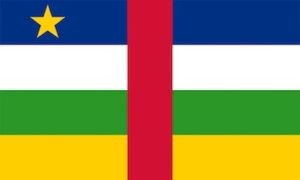
The Central African Republic Flag
*The Central African Republic gained independence from France on this date in 1960. They are a landlocked country in Central Africa.
Its bordered by Chad to the north, Sudan to the northeast, South Sudan to the southeast, DR Congo to the south, the Republic of the Congo to the southwest, and Cameroon to the west. Approximately 10,000 years ago, desertification forced hunter-gatherer societies south into the Sahel regions of northern Central Africa, where some groups settled. Farming began as part of the Neolithic Revolution. Initial farming of white yam progressed into millet and sorghum.
Before 3000 BCE, the domestication of African oil palm improved the groups’ nutrition and allowed for the growth of the local populations. This Agricultural Revolution, combined with a “Fish-stew Revolution,” in which fishing began to take place, and boats’ use allowed for the transportation of goods. Products were moved in ceramic pots, the first known examples of artistic expression from the region’s people. The Bouar Megaliths in the country’s western region indicate an advanced level of habitation dating back to the late Neolithic Era (c. 3500–2700 BCE). Ironworking arrived in the region around 1000 BCE.
The Azande people settled along the Ubangi River in today’s Central and the East-Central African Republic, while Bantoid peoples migrated from the southwest of Cameroon. Bananas arrived in the region during the first millennium BCE and added an important source of carbohydrates to the diet and the production of alcoholic beverages. Production of copper, salt, dried fish, and textiles dominated the economic trade in the Central African region.
Today, the Central African Republic has been inhabited for millennia; however, the country’s current borders were established by France, which ruled the country as a colony starting in the late 19th century after the Berlin Conference in 1884. After gaining independence, the Central African Republic had autocratic leaders, including an abortive attempt at a monarchy. By the 1990s, calls for democracy led to the first multi-party democratic elections in 1993. Ange-Félix Patassé became president but was later removed by General François Bozizé in the 2003 coup. The Central African Republic Bush War began in 2004, and, despite a peace treaty in 2007 and another in 2011, the civil war resumed in 2012.
The civil war perpetuated the country’s poor human rights record, such as armed groups’ widespread and increasing abuses, such as arbitrary imprisonment, torture, and restrictions on freedom of the press and movement. The Central African Republic covers a land area of about 240,000 sq mi. As of 2018, it had an estimated population of around 4.7 million. As of 2022, the Central African Republic is the scene of a civil war, ongoing since 2012.
Most of the Central African Republic consists of Sudano-Guinean savannas. Still, the country also includes a Sahelo-Sudanian zone in the north and an equatorial forest zone in the south. Two-thirds of the country is within the Ubangi River basin (which flows into the Congo), while the remaining third lies in the basin of the Chari, which flows into Lake Chad. Presidential elections were held in December 2015. As no candidate received more than 50% of the vote, the second round of elections was held on February 14, 2016, with run-offs on March 31, 2016. In the second round of voting, former Prime Minister Faustin-Archange Touadéra was declared the winner with 63% of the vote, defeating Union for Central African Renewal candidate Anicet-Georges Dologuélé, another former Prime Minister.
While the elections suffered from many potential voters being absent as they had taken refuge in other countries, the fears of widespread violence were ultimately unfounded. The African Union regarded the elections as successful. Touadéra was sworn in on March 30, 2016. No representatives of the Seleka rebel group or the “anti-balaka” militias were included in the government. Despite its significant mineral deposits and other resources, such as uranium reserves, crude oil, gold, diamonds, cobalt, lumber, and hydropower, as well as significant quantities of arable land, the Central African Republic is among the ten poorest countries in the world, with the lowest GDP per capita at purchasing power parity in the world as of 2017.
As of 2019, according to the Human Development Index (HDI), the country had the second-lowest level of human development (only ahead of Niger), ranking 188 out of 189 countries. The country had the lowest inequality-adjusted Human Development Index (IHDI), ranking 150th out of 150 countries. The Central African Republic is also estimated to be the unhealthiest country and the worst country in which to be young. After Touadéra’s first term, presidential elections were held in December 2020.
Armed groups controlled large parts of the country, so the election could not be conducted in many areas. Some 800 of the country’s polling stations, 14% of the total, were closed due to violence. Three Burundian peacekeepers were killed, and two were wounded during the run-up to the election. President Touadéra was reelected in the first round of December 2020. The Central African Republic is a member of the United Nations, the African Union, the Economic Community of the Central African States, the Organization of International de la Francophonie, and the Nonaligned Movement.